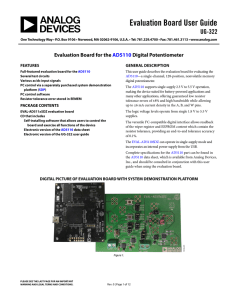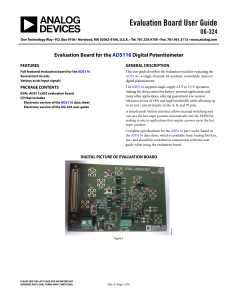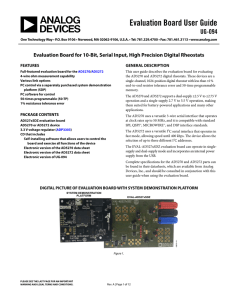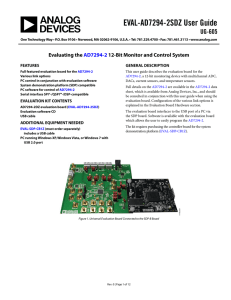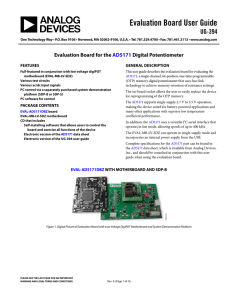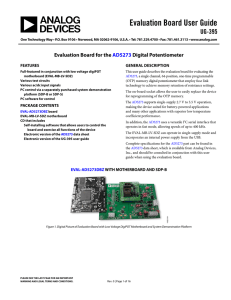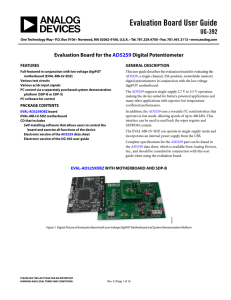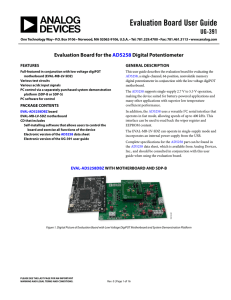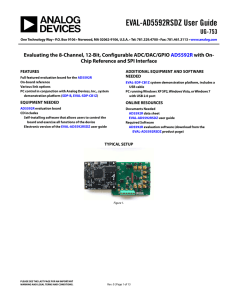Evaluation Board User Guide UG-323
advertisement
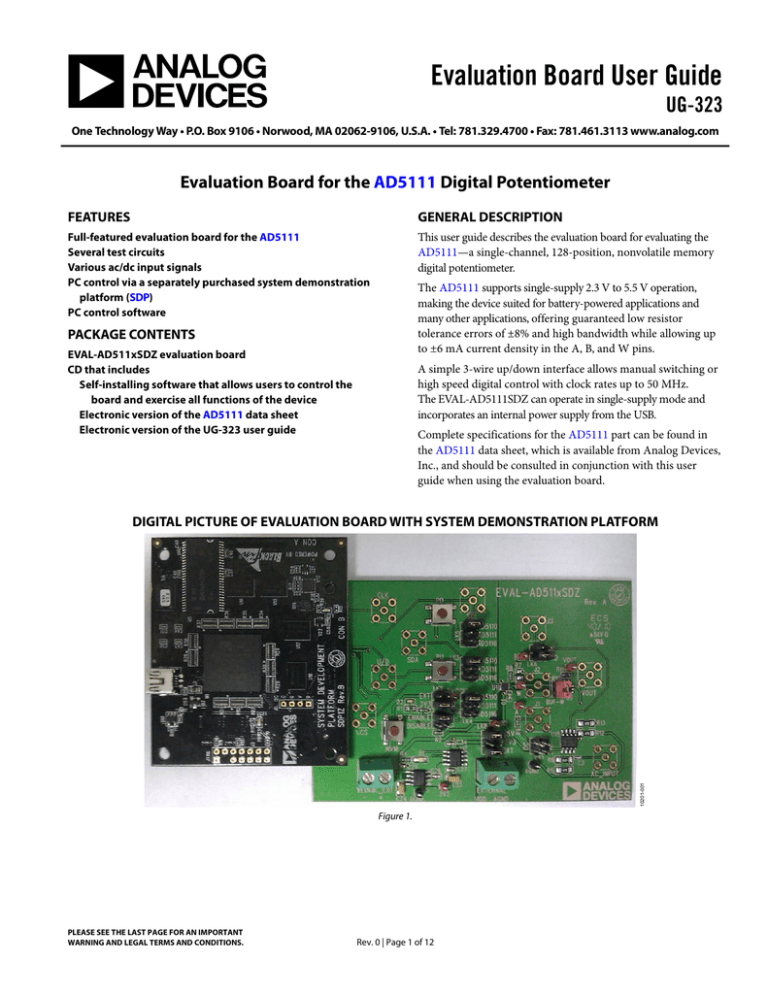
Evaluation Board User Guide UG-323 One Technology Way • P.O. Box 9106 • Norwood, MA 02062-9106, U.S.A. • Tel: 781.329.4700 • Fax: 781.461.3113 www.analog.com Evaluation Board for the AD5111 Digital Potentiometer FEATURES GENERAL DESCRIPTION Full-featured evaluation board for the AD5111 Several test circuits Various ac/dc input signals PC control via a separately purchased system demonstration platform (SDP) PC control software This user guide describes the evaluation board for evaluating the AD5111—a single-channel, 128-position, nonvolatile memory digital potentiometer. The AD5111 supports single-supply 2.3 V to 5.5 V operation, making the device suited for battery-powered applications and many other applications, offering guaranteed low resistor tolerance errors of ±8% and high bandwidth while allowing up to ±6 mA current density in the A, B, and W pins. PACKAGE CONTENTS EVAL-AD511xSDZ evaluation board CD that includes Self-installing software that allows users to control the board and exercise all functions of the device Electronic version of the AD5111 data sheet Electronic version of the UG-323 user guide A simple 3-wire up/down interface allows manual switching or high speed digital control with clock rates up to 50 MHz. The EVAL-AD5111SDZ can operate in single-supply mode and incorporates an internal power supply from the USB. Complete specifications for the AD5111 part can be found in the AD5111 data sheet, which is available from Analog Devices, Inc., and should be consulted in conjunction with this user guide when using the evaluation board. 10201-001 DIGITAL PICTURE OF EVALUATION BOARD WITH SYSTEM DEMONSTRATION PLATFORM Figure 1. PLEASE SEE THE LAST PAGE FOR AN IMPORTANT WARNING AND LEGAL TERMS AND CONDITIONS. Rev. 0 | Page 1 of 12 UG-323 Evaluation Board User Guide TABLE OF CONTENTS Features .............................................................................................. 1 Test Circuits ...................................................................................4 Package Contents .............................................................................. 1 Evaluation Board Software ...............................................................5 General Description ......................................................................... 1 Installing the Software ..................................................................5 Digital Picture of Evaluation Board with System Demonstration Platform ............................................................................................. 1 Running the Software ...................................................................5 Revision History ............................................................................... 2 Evaluation Board Schematics and Artwork ...................................7 Evaluation Board Hardware ............................................................ 3 Ordering Information .................................................................... 11 Power Supplies .............................................................................. 3 Bill of Materials ........................................................................... 11 Operating the Software .................................................................6 Link Options ................................................................................. 3 REVISION HISTORY 11/11—Revision 0: Initial Version Rev. 0 | Page 2 of 12 Evaluation Board User Guide UG-323 EVALUATION BOARD HARDWARE POWER SUPPLIES LINK OPTIONS The EVAL-AD5111SDZ supports using single power supplies. One link option is incorporated in the evaluation board and should be set up before using the board. Table 1 describes the position of the link to control the evaluation board by a PC, via the SDP board, using the EVAL-AD5111SDZ. The functions of this link option is described in detail in Table 3. The evaluation board can be powered either from the SDP port or externally by the EXTERNAL-1 and EXTERNAL-2 connectors, as described in Table 2. All supplies are decoupled to ground using 10 µF tantalum and 0.1 µF ceramic capacitors. Table 1. Link Options Setup for SDP Control (Default) Link No. LK8 Option +5V Table 2. Maximum and Minimum Voltages of the Connectors Connector Number EXTERNAL-1 Label VDD EXTERNAL-2 AGND Voltage Analog positive power supply, VDD. If connected to the SDP, it is 3.3 V to 5.5 V. If controlled externally , it is 2.3 V to 5.5 V. Analog ground, AGND. Table 3. Link Functions Link Number LK8 1 Power Supply VDD Options This link selects one of the following as the positive power supply: +5V (from SDP). +3V3 (from SDP). EXT 1 (external supply from the EXTERNAL-1 connector). If the part is powered using the external connector without connecting the SDP board, +5V jumper must be connected as well. Rev. 0 | Page 3 of 12 UG-323 Evaluation Board User Guide AC Signal Attenuation TEST CIRCUITS The AD5111 can be used to attenuate an ac signal, which must be provided externally using the AC_INPUT connector, as shown in Figure 3. DAC The AD5111 can be operated as a digital-to-analog converter (DAC), as shown in Figure 2. VDD 2 DC AC W B B 12Ω W A B 750Ω A VOUT VDD 2 BUF-W R8 10201-002 Table 4 shows the options available for the voltage references. B LK6 Options AC DC AC GND Description Connects Terminal A to VDD/2 Connects Terminal A to VDD Connects Terminal W to an output buffer Connects Terminal B to VDD/2 Connects Terminal B to analog ground The output voltage is defined in Equation 1. VOUT 12Ω VOUT R7 R8 GND Table 5. AC Signal Attenuation Link Options Table 4. DAC Voltage References BUF-W W B BUF-W Depending on the voltage supply rails and the dc offset voltage of the ac signal, various configurations can be used as described in Table 5. Figure 2. DAC W W Figure 3. AC Signal Attenuator GND Link LK1 AC 750Ω A R9 A R9 Terminal A AC HPF fC = 200Hz AC VDD VDD 2 VDD 2 AC_INPUT 10201-003 The EVAL-AD5111SDZ incorporates several test circuits to evaluate the AD5111 performance. RDAC = (VA − VB ) × 256 Terminal A Link LK1 W BUF-W B LK6 1 Options AC AC1 GND Description Remove dc voltage and biased the signal to VDD/2 Connects Terminal W to an output buffer Connects Terminal B to VDD/2 Connects Terminal B to analog ground Recommended to ensure optimal total harmonic distortion (THD) performance. The signal attenuation is defined in Equation 2. RDAC Attenuation (dB) ≈ 20 × log 128 (1) where: RDAC is the code loaded in the RDAC register. VA is the voltage applied to Terminal A (LK1 link). VB is the voltage applied to Terminal B (LK6 link) (2) where: RDAC is the code loaded in the RDAC register. However, by using the R8 and R9 external resistors, the user can reduce the voltage of the voltage references. In this case, use the A and B test points to measure the voltage applied to the A and B terminals and recalculate VA and VB in Equation 1. In addition, R7 can be used to achieve an exponential attenuation. To do so, adjust the R7 resistor until a desirable transfer function is found, typically around 1.6 kΩ for a 10 kΩ potentiometer. Rev. 0 | Page 4 of 12 Evaluation Board User Guide UG-323 EVALUATION BOARD SOFTWARE INSTALLING THE SOFTWARE RUNNING THE SOFTWARE The EVAL-AD5111SDZ evaluation kit includes evaluation board software provided on a CD. The software is compatible with Windows® XP, Windows Vista, and Windows 7 (both 32 and 64 bits). To run the evaluation board software, do the following: 1. 2. Install the software before connecting the SDP board to the USB port of the PC to ensure that the SDP board is recognized when it is connected to the PC. 1. 2. 3. 4. 5. Start the Windows operating system and insert the CD. The installation software opens automatically. If it does not, run the setup.exe file from the CD. After the installation is completed, power up the evaluation board as described in the Power Supplies section. Plug the EVAL-AD511xSDZ into the SDP board and the SDP board into the PC using the USB cable included in the box. When the software detects the evaluation board, follow the instructions that appear to finalize the installation. Click Start > All Programs > Analog Devices > AD5111 > AD5111 Eval Board. If the SDP board is not connected to the USB port when the software is launched, a connectivity error is displayed (see Figure 4). Connect the evaluation board to the USB port of the PC, wait a few seconds, click Rescan, and follow the instructions. 10201-004 To uninstall the program, click Start > Control Panel > Add or Remove Programs > AD5111 Eval Board. Figure 4. Pop-Up Window Error 10201-005 The main window of the EVAL-AD5111SDZ evaluation software then opens, as shown in Figure 5. Figure 5. EVAL-AD5111SDZ Evaluation Board Software Main Window Rev. 0 | Page 5 of 12 UG-323 Evaluation Board User Guide OPERATING THE SOFTWARE The main window of the EVAL-ADAD5111SDZ software is divided into five different operations: INCREMENT, DECREMENT, SHUTDOWN, STORE, and EXIT. The operations are as follows: • The INCREMENT button increases the RDAC value by the number of steps selected by the window. • • • • Rev. 0 | Page 6 of 12 The DECREMENT button decreases the RDAC value by the number of steps selected by the window. The SHUTDOWN button places the part in shutdown. The STORE button stores the data contained in the RDAC register to the memory. Clicking EXIT closes the program but does not reset the part. Evaluation Board User Guide UG-323 10201-006 EVALUATION BOARD SCHEMATICS AND ARTWORK Figure 6. Schematic of the AD5111 Circuitry Rev. 0 | Page 7 of 12 Evaluation Board User Guide 10201-007 UG-323 Figure 7. Schematic of SDP Connector Rev. 0 | Page 8 of 12 UG-323 10201-008 Evaluation Board User Guide 10201-009 Figure 8. Component Placement Drawing Figure 9. Component Side PCB Drawing Rev. 0 | Page 9 of 12 Evaluation Board User Guide 10201-010 UG-323 Figure 10. Solder Side PCB Drawing Rev. 0 | Page 10 of 12 Evaluation Board User Guide UG-323 ORDERING INFORMATION BILL OF MATERIALS Table 6. Qty 1 1 3 1 1 1 1 6 1 1 1 1 4 2 2 6 1 1 1 1 1 1 Reference Designator C3 C1 C25, C26, C271 C24 D1 EXTERNAL J4 LK1, LK3, LK4, LK5, LK6, LK8 BUF-W R11 R10 R4 R5, R6, R12, R13 R8, R9 DGND, AGND 3V3, A, B, VDD, VOUT, W U1 U3 U5 U7 U15 Description 100 nF, 0402 capacitor 0.1 µF, 0603 capacitor 0.1 µF, 0603 capacitor 10 µF, 1206 capacitor Green LED 2-pin connector Receptacle, 0.6 mm, 120 way Header, 2-row, 36 + 36 way, and jumper socket, black Header, 1-row, 2-way, and jumper socket, black 12 Ω, 0603, 1% resistor 750 Ω, 0603, 1% resistor 1 kΩ, 0603, 0.01% resistor 2.7 kΩ, 1206, 1% resistor 0 Ω, 0603 resistor Test point, PCB, black, PK100 Test point, PCB, red, PK100 AD5111 ADA4860 ADP3303 24LC64 serial EEPROM AD8652 FEC refers to Farnell Electronic Component Distributors. Rev. 0 | Page 11 of 12 Supplier 1/Part Number FEC 1414580 FEC 138-2224 FEC 301-9482 FEC 197-130 FEC 579-0852 FEC 151789 Digi-Key H1219-ND FEC 148-535 and FEC 150-411 FEC 102-2247 and FEC 150-411 FEC 9330534 FEC 9331506 FEC 9330380 FEC 9337288 FEC 9331662 FEC 873-1128 FEC 873-1144 Analog Devices AD5111 Analog Devices ADA4860 Analog Devices ADP3303 FEC 9758070 Analog Devices AD8652 UG-323 Evaluation Board User Guide NOTES I2C refers to a communications protocol originally developed by Philips Semiconductors (now NXP Semiconductors). ESD Caution ESD (electrostatic discharge) sensitive device. Charged devices and circuit boards can discharge without detection. Although this product features patented or proprietary protection circuitry, damage may occur on devices subjected to high energy ESD. Therefore, proper ESD precautions should be taken to avoid performance degradation or loss of functionality. Legal Terms and Conditions By using the evaluation board discussed herein (together with any tools, components documentation or support materials, the “Evaluation Board”), you are agreeing to be bound by the terms and conditions set forth below (“Agreement”) unless you have purchased the Evaluation Board, in which case the Analog Devices Standard Terms and Conditions of Sale shall govern. Do not use the Evaluation Board until you have read and agreed to the Agreement. Your use of the Evaluation Board shall signify your acceptance of the Agreement. This Agreement is made by and between you (“Customer”) and Analog Devices, Inc. (“ADI”), with its principal place of business at One Technology Way, Norwood, MA 02062, USA. Subject to the terms and conditions of the Agreement, ADI hereby grants to Customer a free, limited, personal, temporary, non-exclusive, non-sublicensable, non-transferable license to use the Evaluation Board FOR EVALUATION PURPOSES ONLY. Customer understands and agrees that the Evaluation Board is provided for the sole and exclusive purpose referenced above, and agrees not to use the Evaluation Board for any other purpose. Furthermore, the license granted is expressly made subject to the following additional limitations: Customer shall not (i) rent, lease, display, sell, transfer, assign, sublicense, or distribute the Evaluation Board; and (ii) permit any Third Party to access the Evaluation Board. As used herein, the term “Third Party” includes any entity other than ADI, Customer, their employees, affiliates and in-house consultants. The Evaluation Board is NOT sold to Customer; all rights not expressly granted herein, including ownership of the Evaluation Board, are reserved by ADI. CONFIDENTIALITY. This Agreement and the Evaluation Board shall all be considered the confidential and proprietary information of ADI. Customer may not disclose or transfer any portion of the Evaluation Board to any other party for any reason. Upon discontinuation of use of the Evaluation Board or termination of this Agreement, Customer agrees to promptly return the Evaluation Board to ADI. ADDITIONAL RESTRICTIONS. Customer may not disassemble, decompile or reverse engineer chips on the Evaluation Board. Customer shall inform ADI of any occurred damages or any modifications or alterations it makes to the Evaluation Board, including but not limited to soldering or any other activity that affects the material content of the Evaluation Board. Modifications to the Evaluation Board must comply with applicable law, including but not limited to the RoHS Directive. TERMINATION. ADI may terminate this Agreement at any time upon giving written notice to Customer. Customer agrees to return to ADI the Evaluation Board at that time. LIMITATION OF LIABILITY. THE EVALUATION BOARD PROVIDED HEREUNDER IS PROVIDED “AS IS” AND ADI MAKES NO WARRANTIES OR REPRESENTATIONS OF ANY KIND WITH RESPECT TO IT. ADI SPECIFICALLY DISCLAIMS ANY REPRESENTATIONS, ENDORSEMENTS, GUARANTEES, OR WARRANTIES, EXPRESS OR IMPLIED, RELATED TO THE EVALUATION BOARD INCLUDING, BUT NOT LIMITED TO, THE IMPLIED WARRANTY OF MERCHANTABILITY, TITLE, FITNESS FOR A PARTICULAR PURPOSE OR NONINFRINGEMENT OF INTELLECTUAL PROPERTY RIGHTS. IN NO EVENT WILL ADI AND ITS LICENSORS BE LIABLE FOR ANY INCIDENTAL, SPECIAL, INDIRECT, OR CONSEQUENTIAL DAMAGES RESULTING FROM CUSTOMER’S POSSESSION OR USE OF THE EVALUATION BOARD, INCLUDING BUT NOT LIMITED TO LOST PROFITS, DELAY COSTS, LABOR COSTS OR LOSS OF GOODWILL. ADI’S TOTAL LIABILITY FROM ANY AND ALL CAUSES SHALL BE LIMITED TO THE AMOUNT OF ONE HUNDRED US DOLLARS ($100.00). EXPORT. Customer agrees that it will not directly or indirectly export the Evaluation Board to another country, and that it will comply with all applicable United States federal laws and regulations relating to exports. GOVERNING LAW. This Agreement shall be governed by and construed in accordance with the substantive laws of the Commonwealth of Massachusetts (excluding conflict of law rules). Any legal action regarding this Agreement will be heard in the state or federal courts having jurisdiction in Suffolk County, Massachusetts, and Customer hereby submits to the personal jurisdiction and venue of such courts. The United Nations Convention on Contracts for the International Sale of Goods shall not apply to this Agreement and is expressly disclaimed. ©2011 Analog Devices, Inc. All rights reserved. Trademarks and registered trademarks are the property of their respective owners. UG10201-0-11/11(0) Rev. 0 | Page 12 of 12
